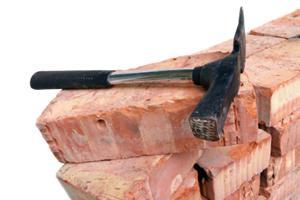| Complexity level: | 7 |
| Project cost ($): | 90 |
| Time required: | 5 days for preparation, 1 day for observation |
| Material availability: | Access to an industrial oven/dry box or kiln is required, in order to achieve temperatures required for baking the bricks. |
| Safety concerns: | Basic safety requirements |
Hypothesis
Coarse sand particles make more durable bricks than fine sand particles.
Overview
Bricks
Bricks are ceramic blocks that are made from clay, sand and water. They are used in construction for building walls and pavements. The bricks are normally secured using mortar while they are being arranged in rows and/or stacked up. Mortar is a mixture of cement, sand and water.
Bricks are normally small in size. This makes it convenient for brick layers to work with them. It also enables construction work to be carried out in small and confined spaces
Bricks are durable and require very little maintenance. They are also non corrosive and are fire resistant
Bricks continue to have a very important place in the construction industry, despite being invented centuries ago.
Scientific Terms
Materials
The materials required for this science fair project are:
- 10 wooden frames ( length 200mm x Width 100mm x Height 65mm)
- 8 liters of clay
- 1 liter of fine sand
- 1 liter of coarse sand
- Tap water
- 2 empty pails
- 1 chair
- 1roll of measurement tape
- 1 large industrial oven or kiln. 1 black marker pen
- 1 bottle of grease
Procedure
1. The independent variable in this science fair project is the type of sand used to make the brick – fine or coarse sand. The dependent variable is the number of times the bricks are dropped before they disintegrate . This is determined by counting the number of times the bricks are dropped from a stipulated height and observing the state of disintegration on the bricks after dropping them. The constants (control variables) are the weight of the brick, the volume of the brick, the mix ratio used to make the brick, the height from which the bricks are dropped and the temperature of the oven.
2. Label 5 wooden frames “fine sand”. Label the emaining 5 frames “coarse sand”. Coat the inner surface of the frames with grease to prevent the bricks from sticking onto the frames.
3. Mix 1 liter of fine sand with 4 liters of clay in an empty pail. Add water and mix until a a soft mixture is obtained. Pour the mixture into the 5 wooden frames labeled “fine sand”.
4. Repeat step 3 using the coarse sand. Use the same amount of water to prepare the mixture. Pour the mixture into the 5 wooden frames labeled “coarse sand”.
5. Leave the 10 wooden frames to dry for 2 days. Separate the bricks from the frames after that. Label the bricks “fine sand” or “coarse sand” respectively depending on the wooden frame from which they are being removed from. Place the bricks in the dry box oven for 24 hours at 900 °C. Remove the bricks from the oven after that and allow them to cool
6. Measure a height of 2 meters using a measuring tape. Dropthe bricks from a height of 2 meters. Do this while standing on a chair. The chair is placed beside a wall and using the measuring tape, a line is drawn on the wall to mark the height of 2 meters. The bricks are then dropped while standing on the chair and holding the brick at that height. Record the number of times the bricks are dropped before they disintegrate in the table provided below.
Results
The brick made from coarse sand is more durable than that made with fine sand. The brick made from coarse sand lasted an average of 2.6 drops while the brick made from fine sand only lasted an average of 1.6 drops.
| Type of sand used | Number of times the bricks are dropped before they break | Average | ||||
| 1 | 2 | 3 | 4 | 5 | ||
| Fine sand | 1 | 2 | 2 | 1 | 2 | 1.6 |
| Coarse sand | 2 | 3 | 3 | 2 | 3 | 2.6 |
Conclusion
The hypothesis that coarse sand particles make more durable bricks than those made of fine sand particles is proven to be true.
Bricks have been used in the construction of homes for hundreds of years. Their high thermal properties have also made them suitable for use to line the walls of furnaces used in glass manufacturing and metallurgy.
Also consider
The science fair project can be repeated by varying the ratios of the materials used to make the bricks or by varying the materials used to make the bricks.
You might also want to consider testing how much compression or weight the bricks are able to bear.
References
http://en.wikipedia.org/wiki/Brick
Brick - http://www.enotes.com/how-products-encyclopedia/brick
Composition of bricks - http://chestofbooks.com/architecture/Construction-Superintendence/215-Composition-of-Bricks.html

